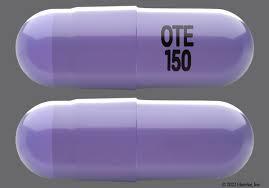Vivjoa
Generic name: oteseconazole
Dosage form: capsules
Drug class: Azole antifungals
What is Vivjoa?
- Vivjoa is a prescription antifungal medicine used to reduce the risk of vaginal yeast infections that keep coming back (recurrent vulvovaginal candidiasis, RVVC) in females with a history of RVVC.
- Vivjoa should only be taken by females who are not pregnant and who are NOT able to become pregnant.
It is not known if this medicine is safe and effective in females who have not had their first menstrual period.
Who should not take Vivjoa?
You should not take Vivjoa if you:
- Are able to become pregnant.
- Are pregnant or plan to become pregnant. Vivjoa may harm your unborn baby. Tell your doctor if you are pregnant, think you might be pregnant, or plan to become pregnant.
- Are breastfeeding or plan to breastfeed. It is not known if Vivjoa passes into your breastmilk.
- Are allergic to oteseconazole or any of the ingredients. See the end of this page for a complete list of ingredients.
Before taking Vivjoa
Before you start treatment, tell your doctor about all of your medical conditions, including if you:
- have kidney problems
- have liver problems
What other drugs will affect Vivjoa?
Tell your doctor about all the medicines you take, including prescription and over-the-counter medicines, vitamins, and herbal supplements.
Especially tell your doctor if you take medicines called breast cancer resistance protein (BCRP) transporter substrates, including:
- rosuvastatin
- prazosin
- glyburide
- cimetidine
- sulfasalazine
- zidovudine
- lamivudine.
Ask your doctor or pharmacist if you are not sure. Taking Vivjoa (a BCRP inhibitor) with BCRP transporter substrates may increase the risk of side effects with these medicines.
Know the medicines you take. Keep a list of them to show your doctor and pharmacist when you get a new medicine.
How should I take Vivjoa?
There are two recommended Vivjoa dosage regimens: one with Vivjoa only, and the other with Vivjoa and fluconazole. Your doctor will advise the best dosage regimen for you.
For the Vivjoa-only Dosage Regimen:
- Take Vivjoa exactly as your doctor tells you to take it. Talk to your doctor if you have any questions.
- On Day 1: Take 600 mg (four capsules as a single dose), by mouth then,
- On Day 2: Take 450 mg (three capsules as a single dose), by mouth then,
- On Day 14: Take 150 mg (one capsule) one time a week (every 7 days) by mouth for 11 weeks.
- Take Vivjoa capsules by mouth with food. Swallow the capsules whole. Do not chew, crush, dissolve, or open the capsules.
For the Vivjoa-fluconazole Dosage Regimen:
- Take fluconazole and Vivjoa exactly as your doctor tells you to take it. Talk to your doctor if you have any questions.
- On Day 1, Day 4, and Day 7: Take 1 fluconazole tablet (150 mg) by mouth, then
- On Days 14 through 20: Take 1 Vivjoa capsule (150 mg) by mouth 1 time each day for 7 days, then
- On Day 28: Take 1 Vivjoa capsule (150 mg) by mouth 1 time each week (every 7 days) for 11 weeks.
- Take Vivjoa capsules by mouth with food. Swallow the capsules whole. Do not chew, crush, dissolve, or open the capsules.
Dosing information
Usual Adult Dosage for Vulvovaginal Candidiasis
Vivjoa-Only Regimen
- On Day 1: Administer Vivjoa 600 mg (as a single dose), then
- On Day 2: Administer 450 mg (as a single dose), then
- Beginning on Day 14: Administer 150 mg once a week (every 7 days) for 11 weeks (Weeks 2 through 12).
Fluconazole/Vivjoa Dosage Regimen
- On Day 1, Day 4, and Day 7: Administer fluconazole 150 mg orally, then
- On Days 14 through 20: Administer Vivjoa 150 mg once daily for 7 days, then
- Beginning on Day 28: Administer Vivjoa 150 mg once a week (every 7 days) for 11 weeks (Weeks 4 through 14).
- Use: to reduce the incidence of recurrent vulvovaginal candidiasis (RVVC) in females with a history of RVVC who are NOT of reproductive potential.
Vivjoa side effects
- Females who are pregnant, are able to become pregnant, and females who are breastfeeding should not take Vivjoa.
The most common side effects are headache and nausea.
These are not all the possible side effects. For more information, ask your doctor or pharmacist. Call your doctor for medical advice about side effects. You may report side effects to FDA at 1-800-FDA-1088.
Related/similar drugs
How should I store Vivjoa?
- Store Vivjoa at room temperature between 68◦F to 77◦F (20◦C to 25◦C).
- Protect from light when removed from the outer carton.
Keep all medicines out of the reach of children and pets.
General information about the safe and effective use of Vivjoa.
Medicines are sometimes prescribed for purposes other than those listed in a Patient Information leaflet. Do not use this medicine for a condition for which it has not been prescribed. Do not give it to other people, even if they have the same symptoms that you have. It may harm them.
You can ask your doctor or pharmacist for information that is written for health professionals.
What are the ingredients in Vivjoa?
Active Ingredient: oteseconazole
Inactive Ingredients: croscarmellose sodium, hydroxypropyl cellulose, lactose, magnesium stearate, silicified microcrystalline cellulose, and sodium lauryl sulfate.
Capsule shell and print constituents: FD&C Blue #1, FD&C Red #3, gelatin, Opacode SW-9008/SW-9009 and titanium dioxide.
Vivjoa does not contain gluten (wheat, barley, or rye).
More about Vivjoa (oteseconazole)
- Check interactions
- Compare alternatives
- Pricing & coupons
- Drug images
- Side effects
- Dosage information
- During pregnancy
- FDA approval history
- Drug class: azole antifungals
- Breastfeeding
- En español
Professional resources
Related treatment guides
Further information
Always consult your healthcare provider to ensure the information displayed on this page applies to your personal circumstances.

